Lightning Current Measurement Method Using Rogowski Coil Based on Integral Circuit with Low-Frequency Attenuation Feedback
Abstract
:1. Introduction
2. Lightning Current Modeling and Spectral Analysis
3. Analysis of Low-Frequency Distortion in Lightning Current Measurements by Rogowski Coils
3.1. Analysis of the Measuring Principle of Rogowski Coils
3.2. Mechanistic Analysis of the Generation of Low-Frequency Distortion in Lightning Current Measurements
4. Integral Correction Method for Lightning Current Measurements by Rogowski Coils
4.1. Integral Correction Optimized Circuit Design
4.1.1. Optimized Design of Integral Correction Circuit
4.1.2. High-Pass Filtering and Voltage-Divided Sampling Circuit Design
4.2. Amplitude–Frequency Characteristics of Rogowski Coil Measurement System Based on Integral Correction
4.3. Parametric Design of Sampling Circuit and Integral Correction Circuit
4.4. Selection of Op-Amps
5. Simulation Verification
6. Conclusions
- This measurement method optimizes the operating characteristics of the active integrated circuit in the low-frequency band by adding a low-frequency attenuation feedback network to the active integrated circuit, which suppresses the effects of the DC bias of the op-amp and low-frequency noise on the measurement.
- In order to satisfy the operating conditions of the op-amp in the active integrator circuit, a high-pass filtering voltage-divided sampling circuit was introduced before the integrator correction circuit.
- From the perspective of the frequency domain, the measurement principle of the entire measurement system was analyzed. The values of each component in each section were designed so that the measurement sensitivity of the measurement system was . Additionally, the lower measurement frequency limit of the measurement system was extended to 20 Hz, the phase error in the low-frequency range was reduced, and the low-frequency distortion caused by measuring lightning currents on transmission lines using a Rogowski coil was corrected.
- Finally, according to the simulation results, it can be seen that the method can accurately restore lightning current signals on transmission lines, which is convenient for accurately locating lightning fault locations in later stages. In addition, the design method can also be used to adjust the measurement range by selecting the appropriate integrator circuit parameters according to the measurement object, which can be applied to other high-frequency pulse current measurements.
Author Contributions
Funding
Institutional Review Board Statement
Informed Consent Statement
Data Availability Statement
Conflicts of Interest
References
- Lazzaretti, A.E.; Santos, S.L.F.; Küster, K.K.; Toledo, L.F.R.B.; Ravaglio, M.A.; Piantini, A.; da Silva Pinto, C.L. An integrated monitoring system and automatic data analysis to correlate lightning activity and faults on distribution networks. Electr. Power Syst. Res. 2017, 153, 66–72. [Google Scholar]
- Ravaglio, M.A.; Küster, K.K.; Santos, S.L.F.; Toledo, L.F.R.B.; Piantini, A.; Lazzaretti, A.E.; de Mello, L.G.; da Silva Pinto, C.L.D. Evaluation of lightning-related faults that lead to distribution network outages: An experimental case study. Electr. Power Syst. Res. 2019, 174, 105848. [Google Scholar]
- Ge, J.M.; Yin, Y.B.; Wang, W. Lightning Current Measurement Form and Arrangement Scheme of Transmission Line Based on Point-Type Optical Current Transducer. Sensors 2023, 23, 7467. [Google Scholar] [CrossRef]
- Ge, J.M.; Shen, Y.; Yu, W.B.; Han, Y.; Duan, F.W. Study on the Application of Optical Current Sensor for Lightning Current Measurement of Transmission Line. Sensors 2019, 19, 5110. [Google Scholar] [CrossRef] [PubMed]
- Zhang, Y.J.; Zhang, Y.; Zou, M.J.; Wang, J.X.; Li, Y.R.; Tan, Y.D.; Feng, Y.W.; Zhang, H.Y.; Zhu, S.X. Advances in Lightning Monitoring and Location Technology Research in China. Remote Sens. 2022, 14, 1293. [Google Scholar] [CrossRef]
- Metwally, I.A. Design of Different Self-Integrating and Differentiating Rogowski Coils for Measuring Large-Magnitude Fast Impulse Currents. IEEE Trans. Instrum. Meas. 2013, 62, 2303–2313. [Google Scholar] [CrossRef]
- Solé-Lloveras, J.; Azpúrua, M.A.; Quilez, M.; Silva, F. Rogowski Coil Sensors for Measuring Lightning Strike Currents on Mechanical Aircraft Joints. IEEE Sens. J. 2023, 23, 4176–4184. [Google Scholar]
- Metwally, I.A. Self-Integrating Rogowski Coil for High-Impulse Current Measurement. IEEE Trans. Instrum. Meas. 2010, 59, 353–360. [Google Scholar] [CrossRef]
- Mei, H.W.; Yan, S.; Zhao, C.L.; Wang, L.M. Research on Lightning Current Sensor Coil Based on Lightning Space Magnetic Field. IEEE Trans. Instrum. Meas. 2018, 67, 1922–1928. [Google Scholar] [CrossRef]
- Metwally, I.A. Multi-layer self-integrating Rogowski coils for high pulsed current measurement. Instrum. Exp. Tech. 2015, 58, 49–58. [Google Scholar] [CrossRef]
- Shi, Y.F.; Xin, Z.; Loh, P.C.; Blaabjerg, F. A Review of Traditional Helical to Recent Miniaturized Printed Circuit Board Rogowski Coils for Power-Electronic Applications. IEEE Trans. Power Electron. 2020, 35, 12207–12222. [Google Scholar] [CrossRef]
- Hagh, A.K.A.; Ashtiani, S.J.; Akmal, A.A.S. A wideband, sensitive current sensor employing transimpedance amplifier as interface to Rogowski coil. Sens. Actuators A Phys. 2017, 256, 43–50. [Google Scholar] [CrossRef]
- Paophan, B.; Kunakorn, A.; Yutthagowith, P. Partial Discharge Measurement Based on an Inductive Mode Air-Core Sensor. J. Electr. Eng. Technol. 2020, 15, 773–785. [Google Scholar] [CrossRef]
- Liu, Y.; Lin, F.C.; Zhang, Q.; Zhong, H.Q. Design and Construction of a Rogowski Coil for Measuring Wide Pulsed Current. IEEE Sens. J. 2011, 11, 123–130. [Google Scholar] [CrossRef]
- Metwally, I.A. Performance Improvement of Slow-Wave Rogowski Coils for High Impulse Current Measurement. IEEE Sens. J. 2013, 13, 538–547. [Google Scholar] [CrossRef]
- Bryant, M.D.; Yan, S.L.; Tsang, R.; Fernandez, B.; Kumar, K.K. A Mixed Signal (Analog-Digital) Integrator Design. IEEE Trans. Circuits Syst. I Regul. Pap. 2012, 59, 1409–1417. [Google Scholar] [CrossRef]
- Samimi, M.H.; Mahari, A.; Farahnakian, M.A.; Mohseni, H. The Rogowski Coil Principles and Applications: A Review. IEEE Sens. J. 2015, 15, 651–658. [Google Scholar] [CrossRef]
- Lee, J.H.; Lim, H.R.; Shin, H.K.; Cho, S.C.; Kim, J.O. Simulation and Development of Rogowski Coil for Lightning Current Measurement. J. Electr. Eng. Technol. 2019, 14, 1831–1839. [Google Scholar] [CrossRef]
- Yutthagowith, P. Rogowski coil with a non-inverting integrator used for impulse current measurement in high-voltage tests. Electr. Power Syst. Res. 2016, 139, 101–108. [Google Scholar] [CrossRef]
- Zhou, Z.; Xin, Z.; Liu, Q.; Li, C.S. A Differential Compensated Air Coil Current Sensor for Switching Current Measurement of Power Devices. IEEE Trans. Ind. Electron. 2023, 70, 5356–5364. [Google Scholar] [CrossRef]
- Ming, L.; Xin, Z.; Liu, W.; Loh, P.C. Structure and modelling of four-layer screen-returned PCB Rogowski coil with very few turns for high-bandwidth SiC current measurement. IET Power Electron. 2020, 13, 765–775. [Google Scholar] [CrossRef]
- IEC 60060-1; High Voltage Testing Techniques—Part 1: General Definitions and Testing Requirements. IEC-Standard: Geneva, Switzerland, 1989.
- Xi, Y.H.; Cui, Y.L.; Tang, X.; Li, Z.W.; Zeng, X.J. Fault Location of Lightning Strikes Using Residual Analysis Based on an Adaptive Kalman Filter. IEEE Access 2019, 7, 88126–88137. [Google Scholar] [CrossRef]
- Grebovic, S.; Oprasic, N.; Helac, V.; Uglesic, I.; Aksamovic, A.; Konjicija, S. An Approach for Estimating Lightning Current Parameters Using the Empirical Mode Decomposition Method. Sensors 2022, 22, 9925. [Google Scholar] [CrossRef] [PubMed]
- Gamerota, W.R.; Elismé, J.O.; Uman, M.A.; Rakov, V.A. Current Waveforms for Lightning Simulation. IEEE Trans. Electromagn. Compat. 2012, 54, 880–888. [Google Scholar] [CrossRef]
- Long, Y.; Yao, C.G.; Mi, Y.; Wang, J.K.; Tang, X.F.; Liao, R.J. Preliminary Full-waveform Inversion of Lightning Current Using Differential-integral Loop Measurement. IEEE Trns. Dielectr. Electr. Insul. 2016, 23, 1534–1545. [Google Scholar] [CrossRef]
- Mingotti, A.; Betti, C.; Tinarelli, R.; Peretto, L.; Rozga, P.; Kunicki, M.; Fulnecek, J. Simplifying Rogowski Coil Modeling: Simulation and Experimental Verification. Sensors 2023, 23, 8032. [Google Scholar] [CrossRef] [PubMed]
- Li, H.; Xin, Z.; Li, X.; Chen, J.L.; Loh, P.C.; Blaabjerg, F. Extended Wide-Bandwidth Rogowski Current Sensor with PCB Coil and Electronic Characteristic Shaper. IEEE Trans. Power Electron. 2021, 36, 29–33. [Google Scholar] [CrossRef]
- Shafiq, M.; Stewart, B.G.; Hussain, G.A.; Hassan, W.; Choudhary, M.; Palo, I. Design and applications of Rogowski coil sensors for power system measurements: A review. Measurement 2022, 203, 10. [Google Scholar] [CrossRef]
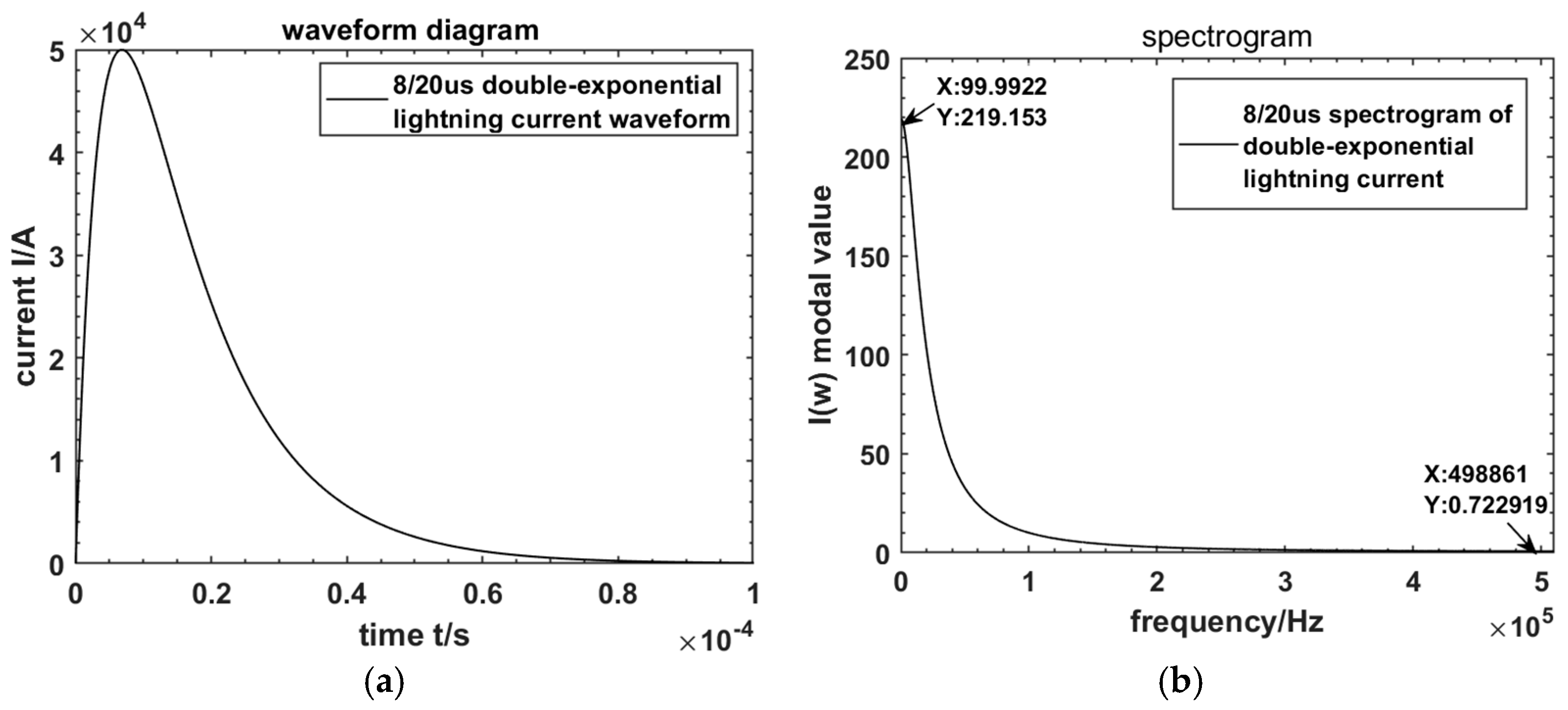
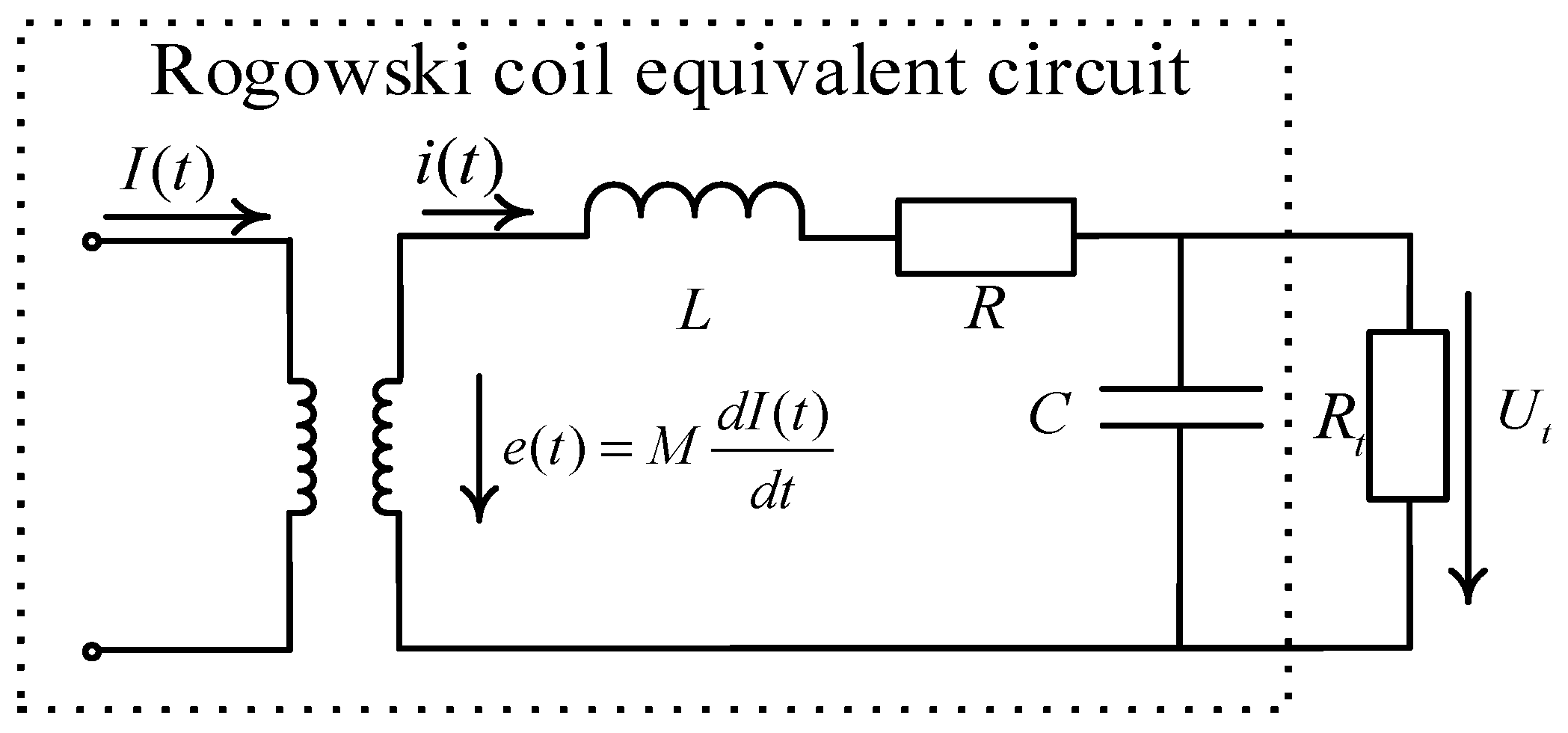


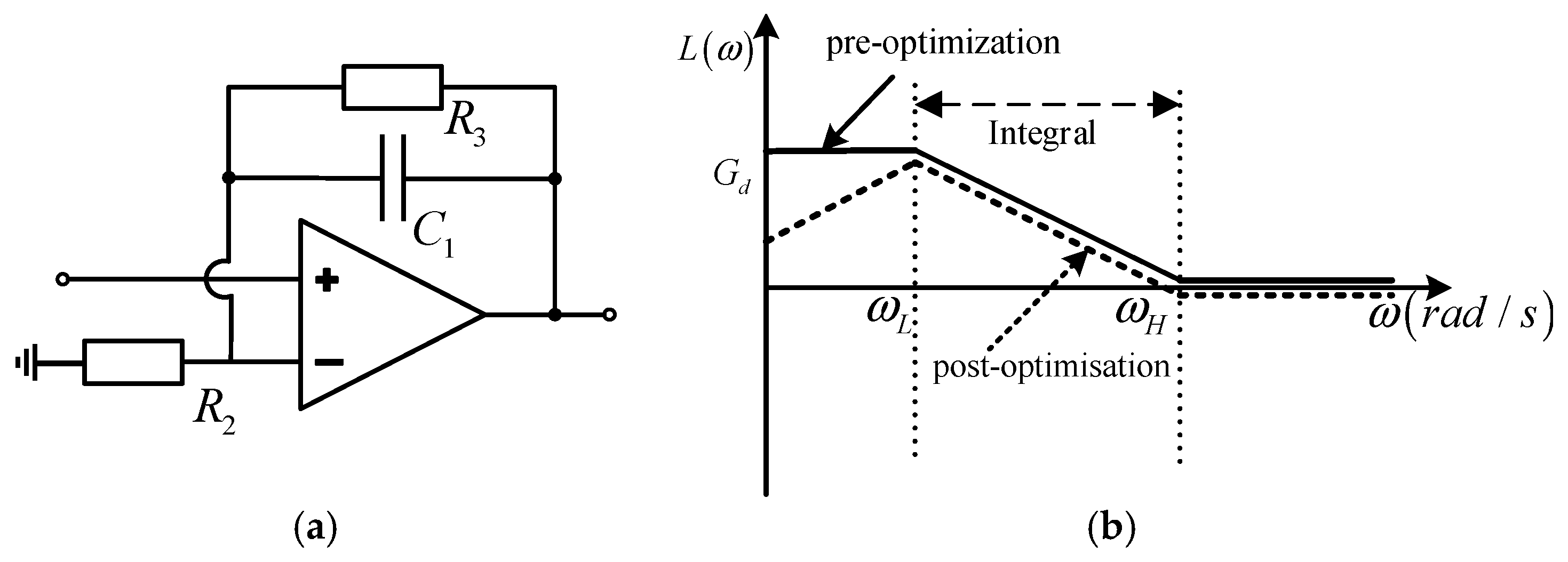

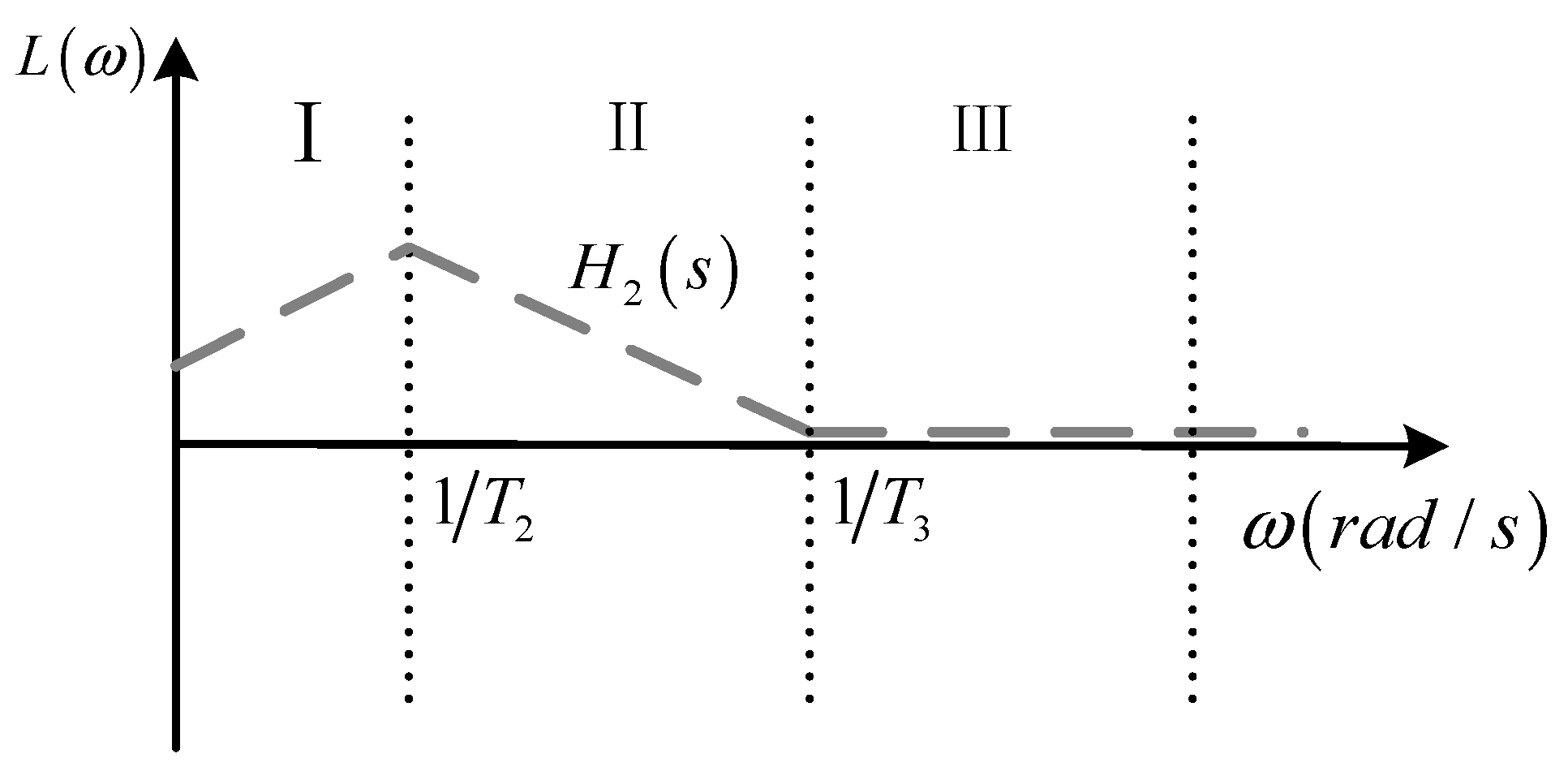
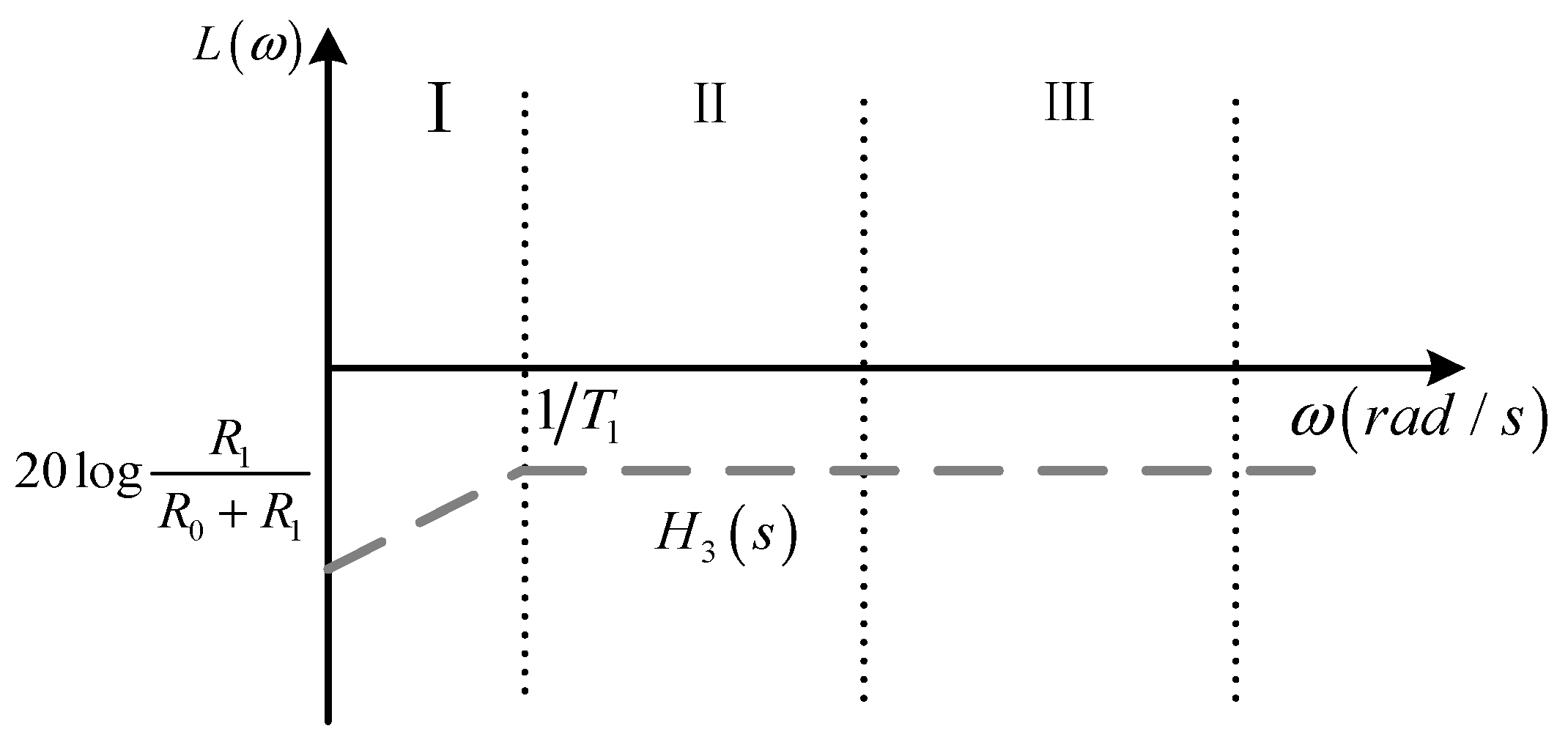
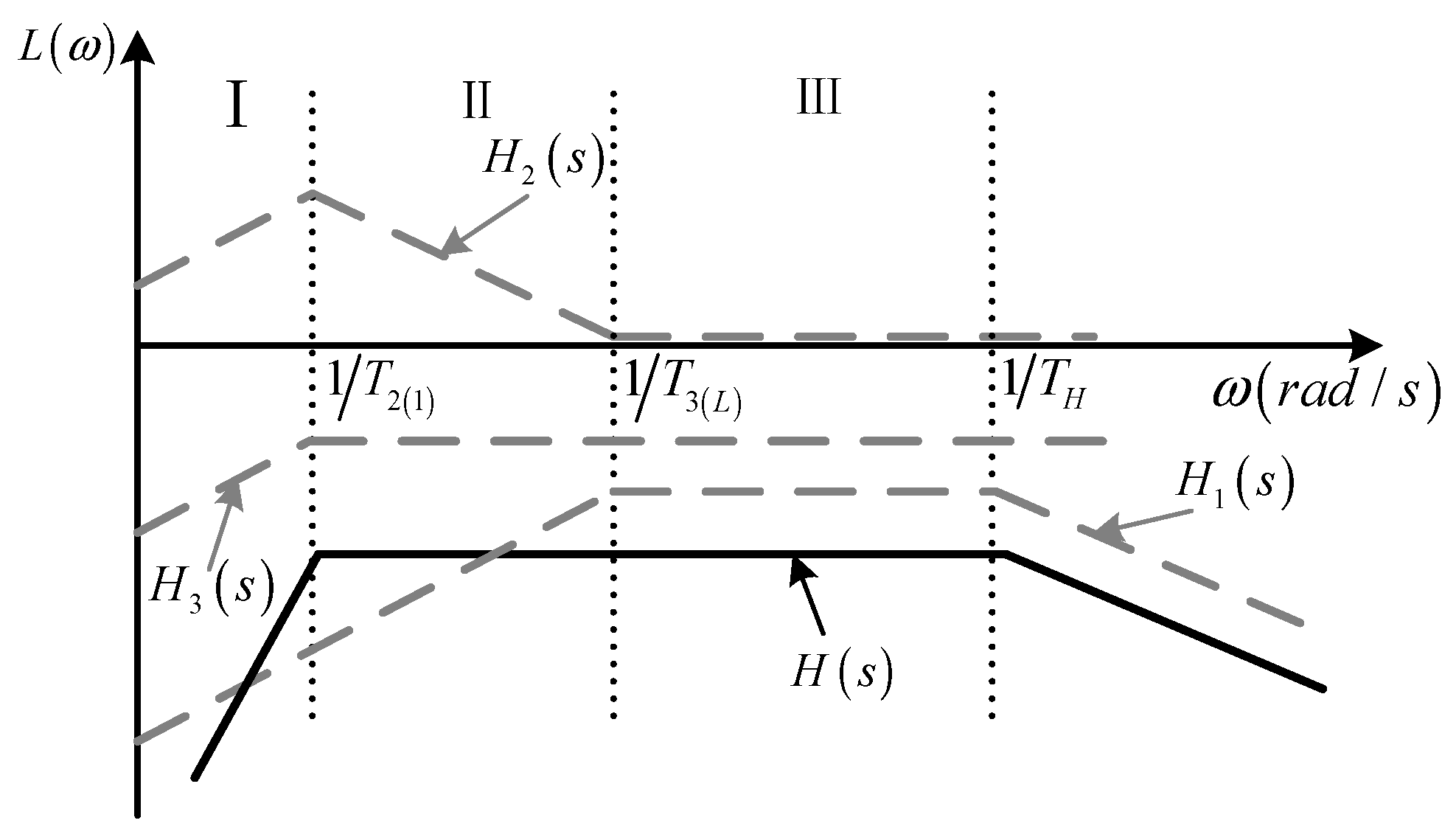

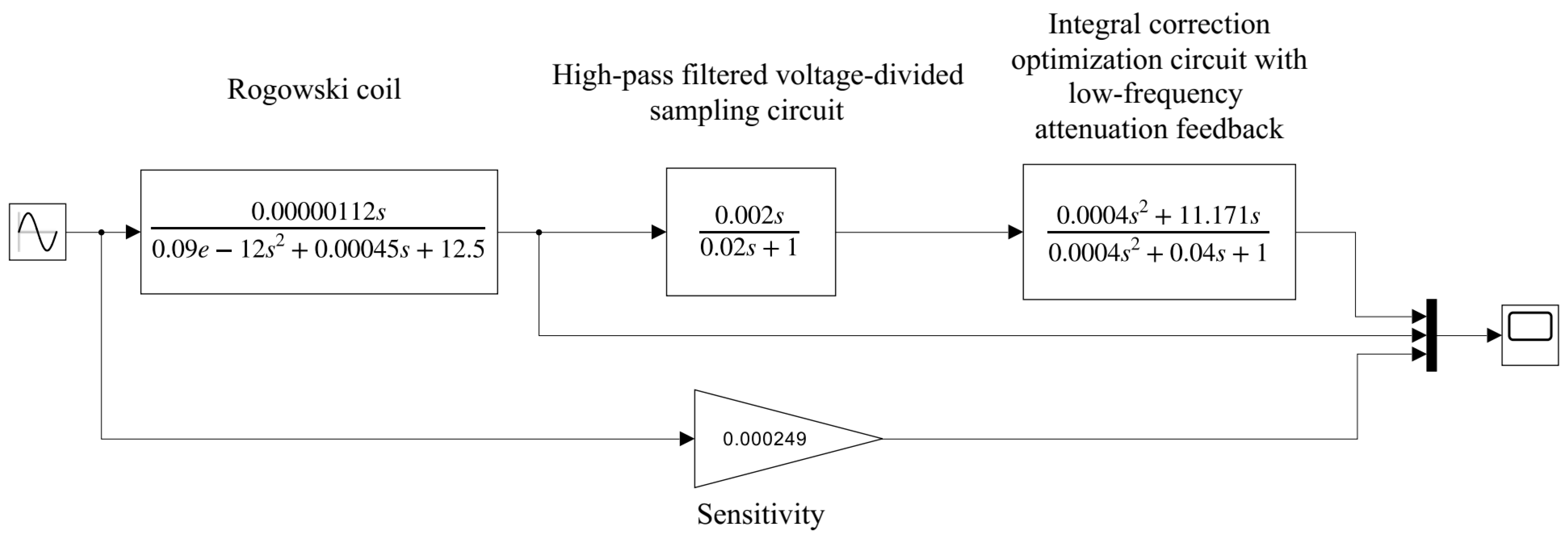



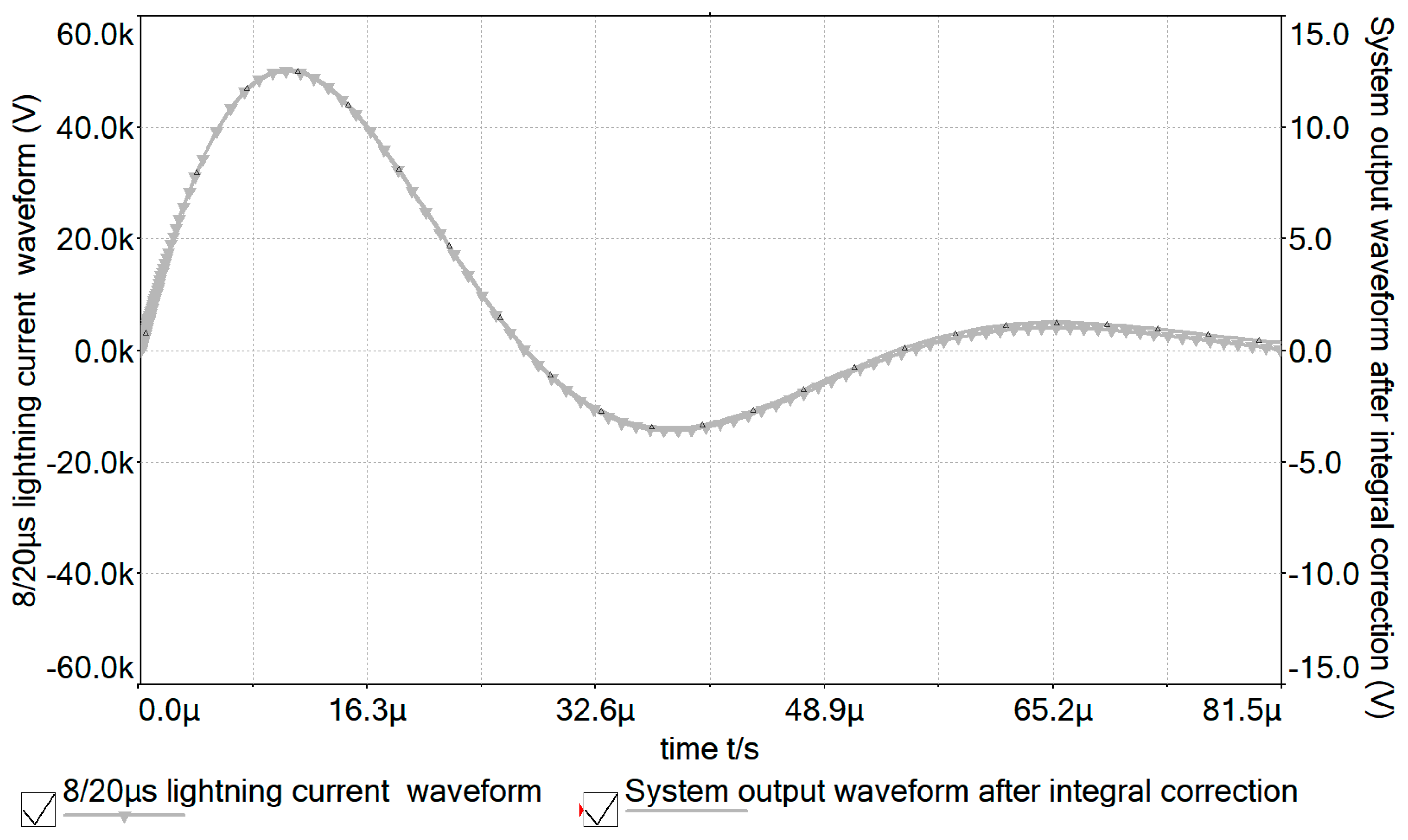
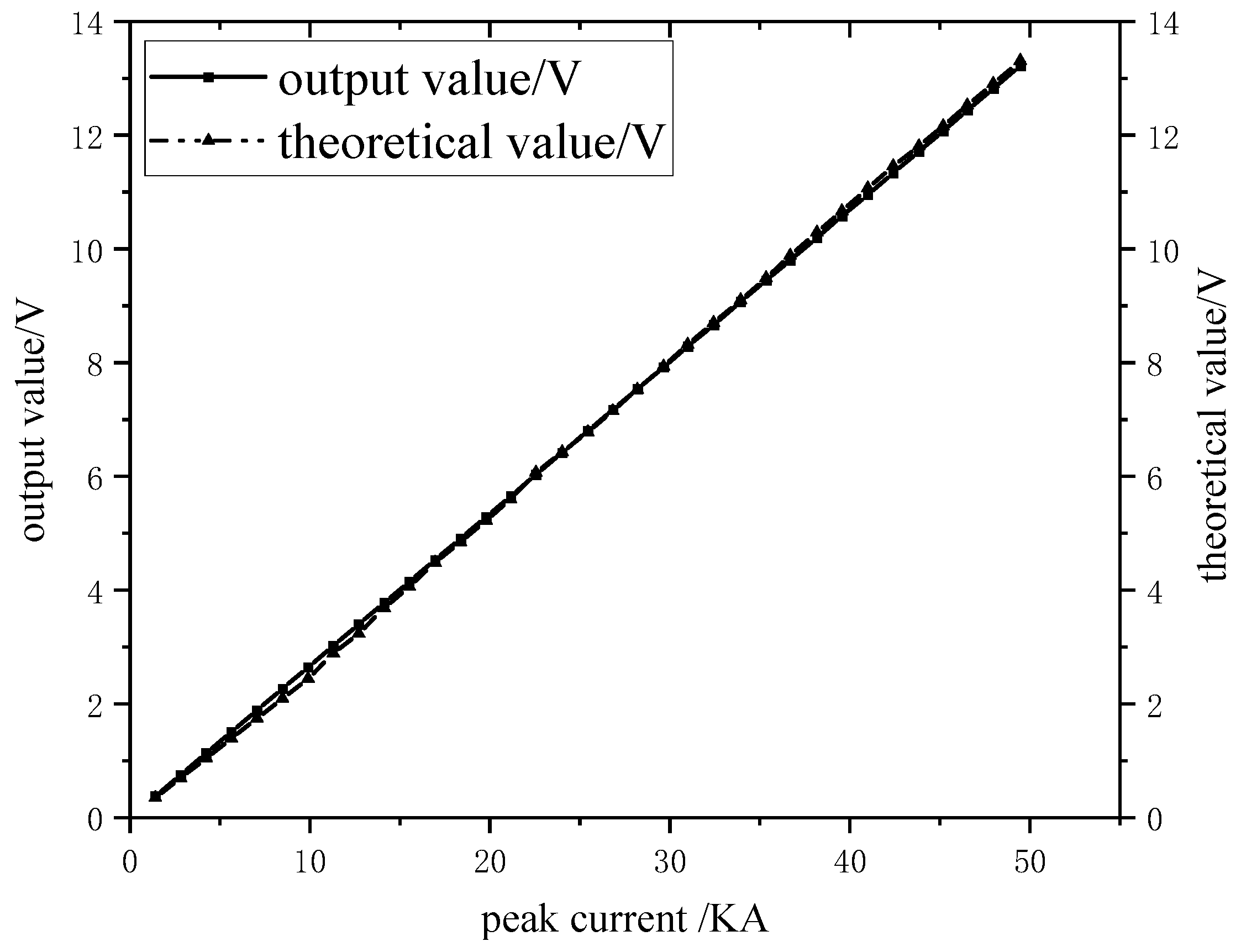
| Parameters | Value |
|---|---|
| Turns/N | 400 |
| Inside diameter D/m | 0.7 |
| External diameter d/m | 0.9 |
| Height h/cm | 5 |
| Mutual inductance | 1.12 |
| Self-inductance | 0.45 |
| Internal resistance | 11.5 |
| Distributed capacitance | 0.20 |
| Sampling resistor | 1 |
| C0/μF | R0/kΩ | R1/kΩ | C1/μF | R2/kΩ | R3/kΩ | R4/kΩ | C2/μF | R5/kΩ |
|---|---|---|---|---|---|---|---|---|
| 0.1 | 180 | 20 | 0.1 | 360 | 100 | 200 | 0.1 | 200 |
Disclaimer/Publisher’s Note: The statements, opinions and data contained in all publications are solely those of the individual author(s) and contributor(s) and not of MDPI and/or the editor(s). MDPI and/or the editor(s) disclaim responsibility for any injury to people or property resulting from any ideas, methods, instructions or products referred to in the content. |
© 2024 by the authors. Licensee MDPI, Basel, Switzerland. This article is an open access article distributed under the terms and conditions of the Creative Commons Attribution (CC BY) license (https://creativecommons.org/licenses/by/4.0/).
Share and Cite
Xiao, Y.; Jiao, H.; Huo, F.; Shen, Z. Lightning Current Measurement Method Using Rogowski Coil Based on Integral Circuit with Low-Frequency Attenuation Feedback. Sensors 2024, 24, 4980. https://doi.org/10.3390/s24154980
Xiao Y, Jiao H, Huo F, Shen Z. Lightning Current Measurement Method Using Rogowski Coil Based on Integral Circuit with Low-Frequency Attenuation Feedback. Sensors. 2024; 24(15):4980. https://doi.org/10.3390/s24154980
Chicago/Turabian StyleXiao, Yiping, Hongjian Jiao, Feng Huo, and Zongtao Shen. 2024. "Lightning Current Measurement Method Using Rogowski Coil Based on Integral Circuit with Low-Frequency Attenuation Feedback" Sensors 24, no. 15: 4980. https://doi.org/10.3390/s24154980





